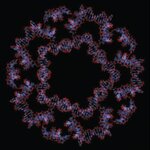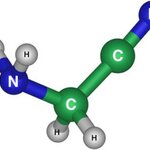Chemistry

DNA, the stuff our genes are made of, is the building material of choice for nanoscale objects. A team led by Günter von Kiedrowski at the Ruhr University in Bochum has now made a dodecahedron (a geometric shape with twelve surfaces) from DNA building blocks. These objects are formed in a self-assembly process from 20 individual trisoligonucleotides, building blocks consisting of a “branching junction” and three short DNA strands.
A regular dodecahedron is a geometric shape made of 12 pentagons of equal size, three of which are connected at every vertex. This results in a structure with 30…

The "Large Molecule Heimat" is a very dense, hot gas clump within the star forming region Sagittarius B2. In this source of only 0,3 light-year diameter, which is heated by a deeply embedded newly formed star, most of the interstellar molecules known to date have been found, including the most complex ones such as ethyl alcohol, formaldehyde, formic acid, acetic acid, glycol aldehyde (a basic sugar), and ethylene glycol.
Starting from 1965, more than 140 molecular species have been detected in space, in interstellar clouds as well as in circumstellar envelopes. A large fraction of these…

Scientists have reconstructed changes in Earth’s ancient ocean chemistry from about 2.5 to 0.5 billion years ago and say that a deficiency of oxygen and the heavy metal molybdenum in the ancient deep ocean may have delayed the evolution of animal life on Earth for nearly 2 billion years.
This research was motivated by a review article published in Science in 2002 by Ariel Anbar, one of the authors of the study and an associate professor at Arizona State University with joint appointments in the Department of Chemistry and Biochemistry and Andy Knoll, a colleague at Harvard University. Knoll…

It may be only St. Patrick's Day but it's never too early to think about July 4th fireworks. Plus, 'green' has two meanings today.
Most kids love fireworks. They make pretty colors and loud noises - but they're not terribily friendly toward the environment. A group of researchers is working on that.
“No other application in the field of chemistry has such a positive association for the general population as fireworks,” says Thomas Klapötke from the University of Munich. “However, pyrotechnical applications are significant polluters of the environment.”
Green is more than just a color…

Fifty years have passed since the United States Department of Agriculture and the U.S. Army invented DEET to protect soldiers from disease-transmitting insects and in the process made civilian life outdoors nicer as well.
Despite its effectiveness, and decades of research, scientists never knew precisely how it worked.
By pinpointing DEET's molecular target in insects, researchers at Rockefeller University have shown that DEET acts like a 'chemical cloak', masking human odors that blood-feeding insects find attractive. This research makes it possible to improve the repellent properties of…

An international team has achieved, by means of a controlled chemical process, that atoms of gold, silver and copper - intrinsically non-magnetic (not attracted to a magnet) - become magnetic.
According to the research, the magnetism appears reduce the dimensions of the material to nanometric dimensions and surround it with previously selected organic molecules. The magnetism of these nanoparticles is a permanent one (like iron) which, even at ambient temperature, is quite significant.
This amazing behavior has been obtained not just with gold (a phenomenon which had already been put…

When chemists want to measure the bonding forces in molecules or other most minuscule forces very accurately, they have to calibrate their measuring instruments (for example the cantilevers, i.e. the measuring tips, of scanning force microscopes). And if it is a matter of comparing the attained results with other results, one must refer to a common basis.
In the case of scanning force microscopes, the nominal values for bending stiffnesses deviate distinctly from the actual values. With the current devices, calibrations of cantilevers are accurate to > 5%. For forces in the nano- and…

Cyanide is poison. Detective writers like it. Gold miners like it. The environment; not so much. In the year 2000 cyanide got into the Tisa river and then into the Danube through a small Austrian gold-mining company's efforts using cyanide to extract gold and silver from solutions. Fish, birds and wild animals died and millions of inhabitants in Hungary were deprived of drinking water.
To prevent future occurrences of that kind, Russian researchers from the Krasnoyarsk State University and the Institute of Chemistry and Applied Chemistry have developed an original method for extracting…

Wool skirts and silk ties may avoid those pricey trips to the dry-cleaner in the future and clean themselves, researchers in Australia and China suggest. They are reporting development of a nanoparticle coating that could lead to “self-cleaning” wool and silk fabrics.
Wool and silk, which are composed of natural proteins called keratins, are among the most prized and widely used fabrics in the clothing industry. However, they are difficult fabrics to keep clean and are easily damaged by conventional cleaning agents. A better way to fight stains in these and other protein-based fabrics is…

The two atoms of an oxygen molecule severed by a metal catalyst usually behave identically, but new research reveals that on a particular catalyst, one oxygen atom plants itself while the other moves away, probably with energy partially stolen from the stationary one.
Scientists from the Pacific Northwest National Laboratory found this unanticipated behavior while studying how oxygen interacts with reduced titanium oxide surfaces. The chemists are trying to understand how molecular oxygen -- the stuff we breathe -- interacts with metals and metal oxides, which are used as catalysts in a…